The Initial Vision
The rapid growth of London and its docks gave rise to a need for better communication across the Thames but early attempts to construct a tunnel met with difficulties owing to the geology. Marc Brunel (father of the better-known I.K. Brunel), having patented a 'tunnelling shield', obtained finance in 1824 for the ultimately-successful project to build the Thames Tunnel. The project suffered a succession of problems and Marc's 20-year old son Isambard became involved and was awarded a silver medal by the Royal Humane Society in 1828 for his bravery in saving lives during serious floodings of the workings (Royal Humane Society Report). Eventually, in 1843, the tunnel was completed as a twin tunnel with frequent cross-passages between Wapping and Rotherhithe. A plaque erected by London Transport at Wapping Station announces the tunnel's pioneering status:-
The tunnel which runs under the Thames from this station was the first tunnel for public traffic ever to be driven beneath a river.
It was designed by Sir Marc Isambard Brunel 1769-1849 and completed in 1843
His son Isambard Kingdom Brunel 1806-1859 was engineer-in-charge from 1825 to 1828.

Commemorative plaque in Wapping station.
The cost overruns meant that approach ramps allowing the tunnel to be used by horse drawn carriages as originally intended could not be financed so, by placing stairways in the construction shafts on either side of the river, the tunnel was opened only to pedestrians. It was not a commercial success, despite becoming a major tourist attraction with numerous stalls in the tunnel selling souvenirs.
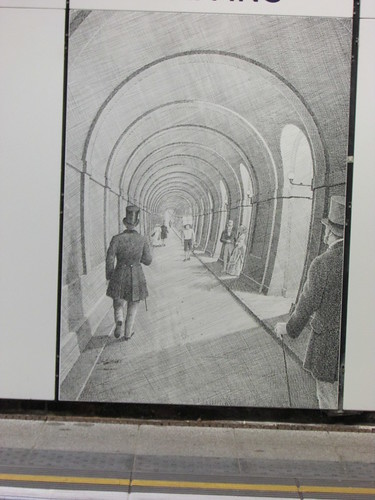
Wapping station: Modern mural showing Thames Tunnel as a pedestrian tunnel.
The building at Rotherhithe which originally housed the pump for the Thames tunnel is now The Brunel Museum Thames Tunnel, with a website here.
Conversion to railway use
Although the Tunnel had not achieved its aim of providing a cross-river link for horse-drawn vehicles, its dimensions allowed it to be adapted for rail traffic and, in 1865, the tunnel was purchased by the East London Railway. This was a joint venture by six railways hoping to profit from better freight and passenger connections across the river:-
Great Eastern Railway(The last three railways ultimately formed part of the Southern Railway and there are brief histories of these lines in two posts 'Origins of the Southern Railway' listed in 'Related posts on this site' below).
Metropolitan Railway
District Railway
London, Brighton & South Coast Railway
London, Chatham and Dover Railway
South Eastern Railway
With Sir John Hawkshaw as engineer, the tunnel was converted and approaches built allowing its use as a double-track railway which was extended on both side of the Thames with a number of stations and making connections with the participating railways. The work was carried out in stages and completed by 1884.
The Great Eastern terminus at Liverpool Street was the northern extremity of the East London Line passenger service. Rather inconveniently, freight trains to and from the Great Eastern had to reverse at Liverpool Street. Alternately, there was provision for transferring wagons (two at a time) a hoist at Spitalfields. North of the river, stations were provided at Shoreditch, Whitechapel, Shadwell and Wapping. South of Whitechapel station, St. Mary's Curve provided a connection to the route operated jointly by the Metropolitan and Metropolitan District railways.
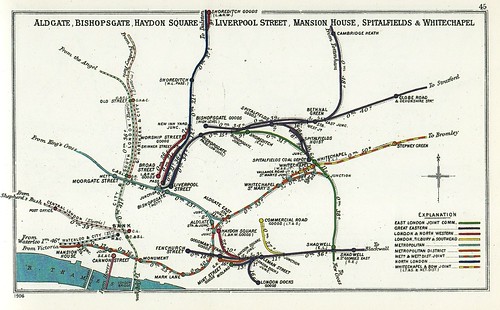
Northern section of East London Railway in 1906 (Railway Clearing House).
Click here for larger view.
South of the river, the line passed through Rotherhithe and Deptford Road stations before dividing into three branches which joined the L.B.S.C.R. South London Line to Victoria, the L.B.S.C.R. Croydon and Brighton Line from London Bridge and the S.E.&C.R. line from London Bridge.
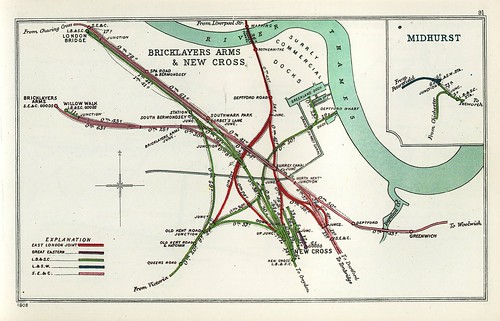
Southern section of East London Railway in 1908 (Railway Clearing House).
Click here for larger view.
The well-known 'Brighton Terriers' were one of the locomotive types commonly used on passenger trains on the East London Line.

A modern mural at Wapping showing a steam-hauled Northbound passenger train arriving at Wapping station.
London Underground
In 1933, the East London Line was taken over by the London Passenger Transport Board and was operated by London Underground. Between Shoreditch and two southern termini at New Cross Gate and New Cross gate the line was electrified using the standard Fourth Rail Electrification arrangements (as outlined in the post here) and Metropolitan Line rolling stock based at a depot at New Cross. When heavy repairs were required, the trainsets travelled to Neasden, accessing the main Metropolitan route using St. Mary's Curve. Freight trains continued to use the line until the 1960s. Apart from a morning and evening 'rush', the East London Line was fairly quiet and it continued as a rather 'forgotten line'.
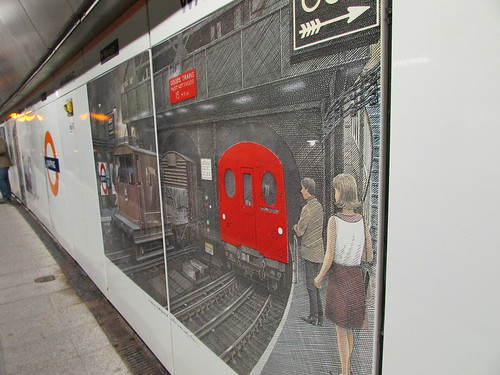
A modern mural at Wapping showing a Northbound electric train arriving at Wapping station, passing a freight train.
Temporary closure in 1995
In 1995 the line was completely closed to allow repairs to the Thames Tunnel itself and the building of an interchange station at Canada Water with the Jubilee Line which was being constructed. The use of 'shotcreting' in the Thames Tunnel proved contentious and a short section was preserved as-built. The repair work included replacement of the elderly Tunnel Telephone system required on the underground sections of the line and my firm supplied the new equipment. In 1998, the East London Line re-opened, continuing the earlier services from Whitechapel (Shoreditch during the 'rush') and either New Cross or New Cross Gate.
London Overground Era
In 2007, the London Overground had taken over operation of a number of mainly North London services including Euston to Watford, Clapham Junction to Willesden, Stratford and Barking. More ambitious plans were accepted to add an extended and modernised East London Line to the London Overground Network. The East London Line closed again in 2007 allowing re-signalling, station upgrades and building of a depot for the new trains at New Cross Gate. The electrification system was converted to third rail 750 volts d.c. and the technical changes necessitated replacement of the Tunnel Telephone equipment on the East London Line which, again, my company supplied.
Rolling Stock
The London Overground is operated by various versions of Class 378, built by Bombardier at Derby. There were originally three variants - 378/0 3-car, 378/1 4-car d.c. and 378/2 4-car a.c./d.c.

Newly-built Class 378 at Bombardier, Litchurch Lane, Derby in 2009.
East London Line re-opening
The East London Line re-opened in 2010 with modern, full-size trains through the Thames Tunnel from Highbury & Islington in the North to New Cross and, via New Cross Gate and existing Network Rail lines, to West Croydon and Crystal Palace in the south. I travelled on part of the new line in June 2010 and there's a short post here.
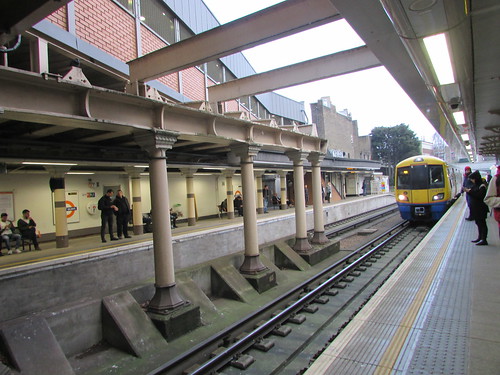
East London Line: Up train entering Surrey Quays station.

East London Line Service Control Centre ('OBC'), viewed from a London Bridge - East Croydon train.
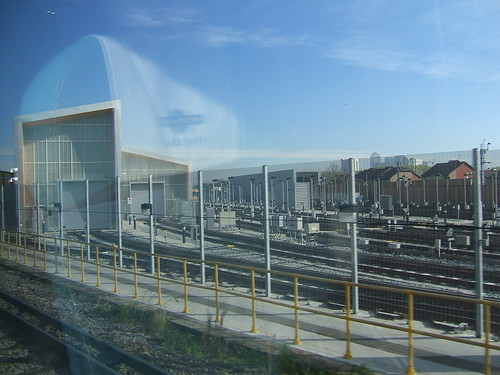
New Cross Gate London Overground Depot, viewed from a London Bridge - East Croydon train.
London Overground Expansion
The new services have proved popular. There are now 57 trainsets - the 378/0 were converted to 378/1 and both 378/1 and 378/2 have been augmented to 5-car sets in an attempt to meet increased demand, necessitating elective door opening at certain East London Line stations with short platforms.
The abandoned connection south of Surrey Quays with the former South London Line has been re-instated (with a grade-separated junction at Silwood Junction, South of Surrey Quays), adding a service via the Thames Tunnel to Clapham Junction. With change of trains, the London Overground now provides a 'ring' service around London.
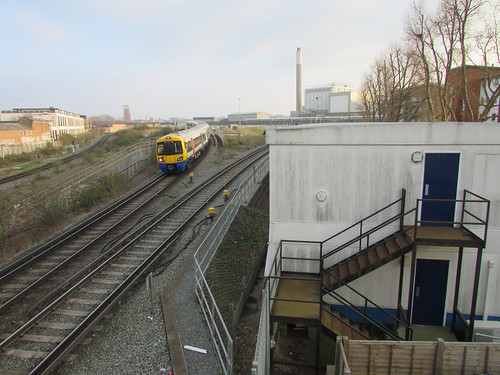
Silwood Junction looking south. Trainset 378 149 on Up passing over the bridge carrying the Down South London. The line converging from the right is the Up South London.
Book References
Track diagrams showing the early stages of the redevelopment of the East London Line as part of the London Overground system are shown in the 2008 publication:-
‘Railway Track Diagrams Book 5: Southern and TfL’ (TRACKmaps: 3rd edition) ISBN 978-0-9549866-4-3.
Related posts on other sites
Thames Tunnel (Wikipedia).
East London Line Extension (Wikipedia).
East London Line (Wikipedia).
British Rail Class 378 (Wikipedia).
Clive's UndergrounD Line Guides: East London Line.
Related posts on this site
East London Line (2010 re-opening).
Origins of the Southern Railway: Part 2: L.B.S.C.R.
Origins of the Southern Railway: Part 3 - S.E.C.R.
Fourth Rail Electrification.
My Pictures
Where necessary, clicking on an image above will display an 'uncropped' view or, alternately, pictures from may be selected, viewed or downloaded, in various sizes, from the album listed:-
London: East London Line.
Railway Clearing House Junction Diagrams.
